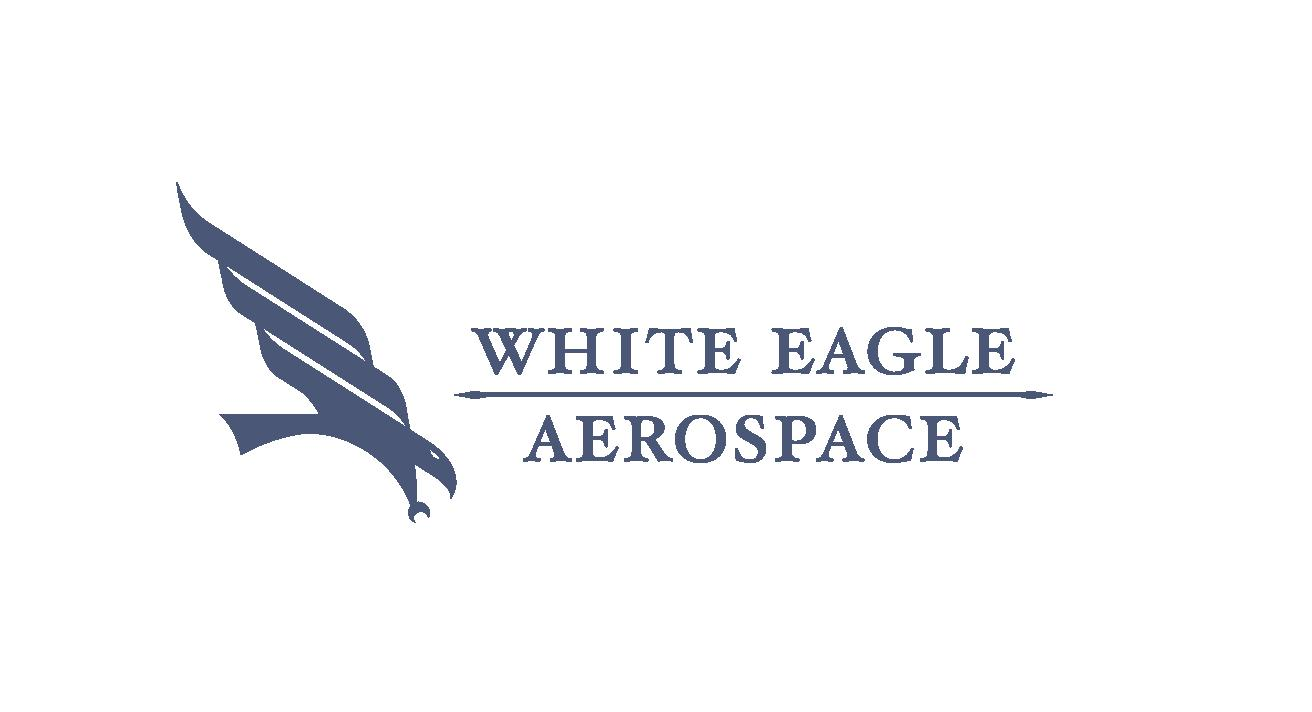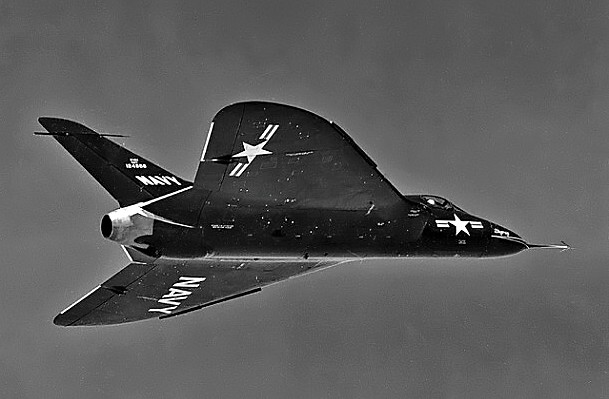
Sixty-four years ago this month, the USN/Douglas XF4D-1 Skyray fighter flew for the first time at Edwards Air Force Base in California. Douglas test pilot Robert O. Rahn was at the controls of the single-engine, carrier-based, supersonic-capable aircraft.
The Douglas XF4D-1 was the prototype version of the United States Navy’s F4D-1 Skyray. Designed to intercept adversary aircraft at 50,000 feet within 300 seconds of take-off, development of the Skyray began in the late 1940’s. As an aside, the Skyray nickname derived from the type’s large delta wing which gave it the appearance of a Manta ray.
The Skyray was originally designed to be powered by a Westinghouse XJ40-WE-6 turbojet capable of 7,000 lbs of sea level thrust. However, when significant developmental problems were encountered with that power plant, Douglas substituted an Allison J35-A-17 turbojet to support early flight testing of the XF4D-1. With a maximum sea level thrust of 5,000 lbs, the J35 rendered these early airframes significantly underpowered.
A pair of XF4D-1 Skyray airframes were built by Douglas. Ship No. 1 was assigned tail number BuAer 124586 while Ship No. 2 received the designation BuAer 124587.
On Tuesday, 23 January 1953, XF4D-1 Ship No. 1 (BuAer No 124586) departed Edwards Air Force Base on its first ride into the wild blue. Doing the piloting honors on this occasion was highly regarded Douglas test pilot Bob Rahn. The delta-winged beauty performed well on this maiden flight which concluded with Rahn making an uneventful landing back at Edwards.
Extensive flight testing of the Skyray, including carrier trials, continued through 1955. The Westinghouse XJ40-WE-8 appeared on the scene during this time. Rated at 11,600 lbs of sea level thrust in afterburner, this power plant allowed the Skyray to establish several speed records in California during October of 1953. Specifically, a speed of 752.944 mph was registered within a 3-kilometer course over the Salton Sea followed by 100-kilometer closed course mark of 728.11 mph at Edwards AFB.
Unfortunately, the XJ40 would prove to be very temperamental and unreliable. Inflight engine fires, explosions, and component failures constantly plagued the Skyray program. Westinghouse never did solve these problems to the satisfaction of the Navy. As a result, the service eventually opted to power production aircraft with the Pratt and Whitney J57-P-8 turbojet (10,200 lbs of sea level thrust).
The Douglas F4D-1 Skyray went on to serve with the United States Navy and Marines from 1956 through 1964. A total of 420 aircraft were produced. While never used in anger, the Skyray was a solid performer and served well in its intended role as a point design interceptor.
The Skyray holds the distinction of being the last fighter produced by the Douglas Aircraft Company before this legendary aerospace giant merged with McDonnell Aircraft to form McDonnell Douglas.
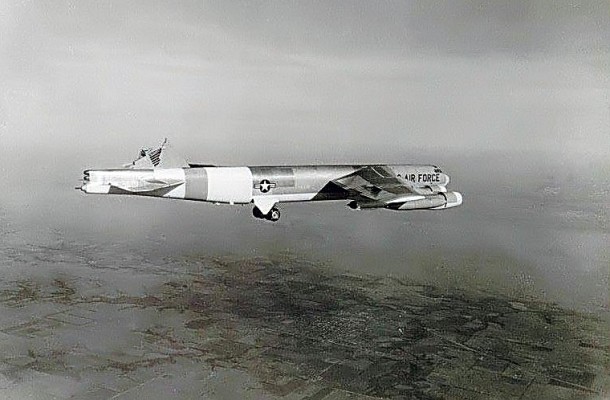
Fifty-three years ago this week, a USAF/Boeing B-52H Stratofortress landed safely following structual failure of its vertical tail during an encounter with unusually severe clear air turbulence. The harrowing incident occurred as the aircraft was undergoing structural flight testing in the skies over East Spanish Peak, Colorado.
Turbulence is the unsteady, erratic motion of an atmospheric air mass. It is attributable to factors such as weather fronts, jet streams, thunder storms and mountain waves. Turbulence influences the motion of aircraft that are subjected to it. These effects range from slight, annoying disturbances to violent, uncontrollable motions which can structurally damage an aircraft.
Clear Air Turbulence (CAT) occurs in the absence of clouds. Its presence cannot be visually observed and is detectable only through the use of special sensing equipment. Hence, an aircraft can encounter CAT without warning. Interestingly, the majority of in-flight injuries to aircraft crew and passengers are due to CAT.
On Friday, 10 January 1964, USAF B-52H (S/N 61-023) took-off from Wichita, Kansas on a structural flight test mission. The all-Boeing air crew consisted of instructor pilot Charles Fisher, pilot Richard Curry, co-pilot Leo Coors, and navigator James Pittman. The aircraft was equipped with accelerometers and other sensors to record in-flight loads and stresses.
An 8-hour flight was scheduled on a route that from Wichita southwest to the Rocky Mountains and back. The mission called for 10-minutes runs of 280, 350 and 400 KCAS at 500-feet AGL using the low-level mode of the autopilot. The initial portion of the mission was nominal with only light turbulence encountered.
However, as the aircraft turned north near Wagon Mound, New Mexico and headed along a course parallel to the mountains, increasing turbulence and tail loads were encountered. The B-52H crew then elected to discontinue the low level portion of the flight. The aircraft was subsequently climbed to 14,300 feet AMSL preparatory to a run at 350 KCAS.
At approximately 345 KCAS, the Stratofortress and its crew experienced an extreme turbulence event that lasted roughly 9 seconds. In rapid sequence the aircraft pitched-up, yawed to the left, yawed back to the right and then rolled right. The flight crew desperately fought for control of their mighty behemoth. But the situation looked grim. The order was given to prepare to bailout.
Finally, the big bomber’s motion was arrested using 80% left wheel authority. However, rudder pedal displacement gave no response. Control inputs to the elevator produced very poor response as well. Directional stability was also greatly reduced. Nevertheless, the crew somehow kept the Stratofortress flying nose-first.
The B-52H crew informed Boeing Wichita of their plight. A team of Boeing engineering experts was quickly assembled to deal with the emergency. Meanwhile, a Boeing-bailed F-100C formed-up with the Stratofortress and announced to the crew that most of the aircraft’s vertical tail was missing! The stricken aircraft’s rear landing was then deployed to add back some directional stability.
With Boeing engineers on the ground working with the B-52H flight crew, additional measures were taken in an effort to get the Stratofortress safely back on the ground. These measures included a reduction in airspeed, controlling aircraft center-of-gravity via fuel transfer, judicious use of differential thrust, and selected application of speedbrakes.
Due to high surface winds at Wichita, the B-52H was vectored to Eaker AFB in Blytheville, Arkansas. A USAF/Boeing KC-135 was dispatched to escort the still-flying B-52H to Eaker and to serve as an airborne control center as both aircraft proceeded to the base. Amazingly, after flying 6 hours sans a vertical tail, the Stratofortress and her crew landed safely.
Safe recovery of crew and aircraft brought additional benefits. There were lots of structural flight test data! It was found that at least one gust in the severe CAT encounter registered at nearly 100 mph. Not only were B-52 structural requirements revised as a result of this incident, but those of other existing and succeeding aircraft as well.
B-52H (61-023) was repaired and returned to the USAF inventory. It served long and well after its close brush with catastrophy in January 1964. The aircraft spent the latter part of its flying career as a member of the 2nd Bomb Wing at Barksdale AFB, Louisiana. The venerable bird was retired from active service in July of 2008.
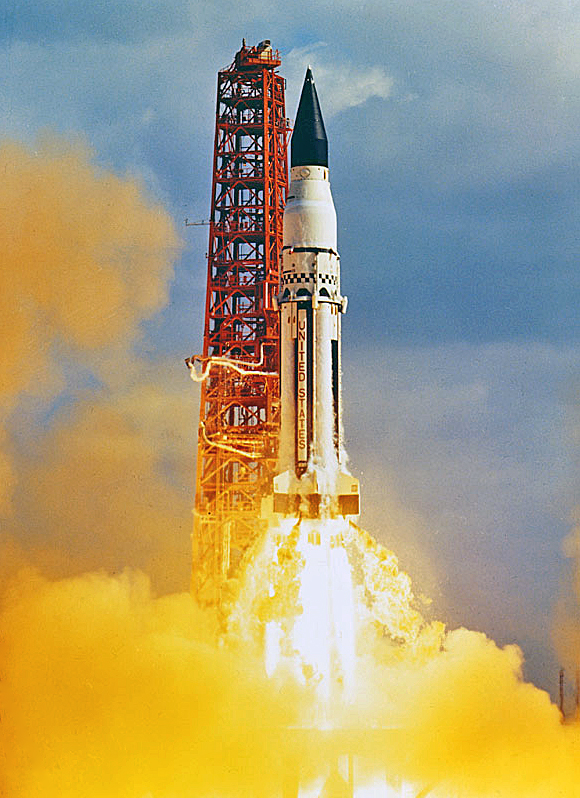
Fifty-three years ago this month, NASA successfully launched the first Saturn I Block II heavy-lift launch vehicle. Known as Saturn-Apollo No. 5 (SA-5), the mission featured the largest mass ever orbited up to that time in the history of spaceflight.
The Saturn I was a pathfinder rocket booster that ultimately lead to the development of the mighty Saturn V launch vehicle. Ten (10) Saturn I boosters were flown between October 1961 and July 1965. The first four (4) missions involved the Block I variant wherein only the first stage was powered. The final six (6) missions employed Block II vehicles which included live first and second stages.
The Saturn I measured 164 feet in length with a maximum diameter of 21.42 feet. The S-I first stage was powered by an octet of Rocketdyne H-1 engines that generated a total sea level thrust of 1,500,000 lbs. The S-IV seconds stage incorporated six (6) Pratt and Whitney RL10 engines rated at a total vacuum thrust of 900,000 lbs.
SA-5 was launched from LC-37 at Cape Canaveral, Florida on Wednesday, 29 January 1964. Weighing 1,121,680 lbs at first stage ignition, the vehicle lifted-off at 14:25:01 UTC. As the first and second stages functioned in splendid fashion, the second stage successfully achieved an elliptical orbit measuring 142 x 415 nm.
The SA-5 orbited mass of 37,700 lbs was a record for the time. This payload, consisting of the S-IV stage, an instrument unit, and a modified Jupiter nose cone filled with sand ballast, remained in orbit through the end of April 1966.
The SA-5 mission was significant for a variety of reasons. It featured the first live S-IV rocket stage and was the first Saturn I vehicle to achieve orbit. It also marked that moment in spaceflight history when America finally surpassed the Soviet Union in payload mass to orbit capability. Known as “closing the booster gap”, this event was an important step in the race to the moon in which America would be the ultimate victor.
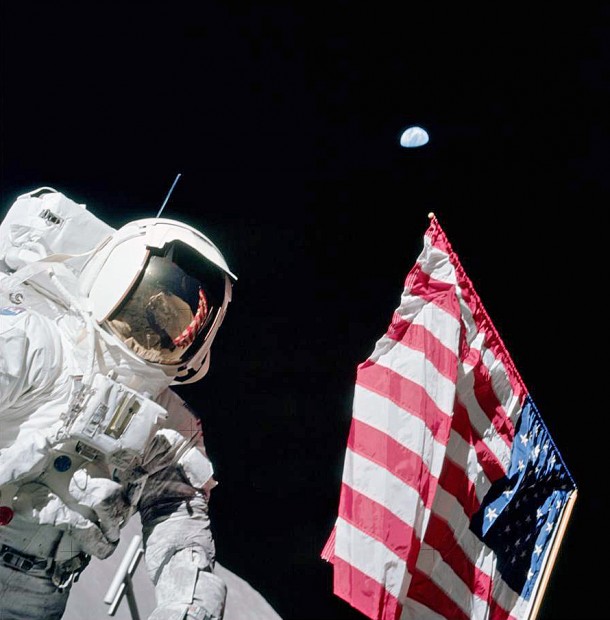
Forty-four years ago this month, NASA successfully conducted the sixth lunar landing mission of the Apollo Program. Known as Apollo 17, the flight marked the last time that men from the planet Earth explored the surface of the Moon.
Apollo 17 was launched from LC-39A at Cape Canaveral, Florida on Thursday, 07 December 1972. With a lift-off time of 05:33:00 UTC, Apollo 17 was the only night launch of the Apollo Program. Those who witnessed the event say that night turned into day as the incandescent exhaust plumes of the Saturn V’s quintet of F-1 engines lit up the sky around the Cape.
The target for Apollo 17 was the Taurus-Littrow valley in the lunar highlands. Located on the southeastern edge of Mare Serenitatis, the landing site was of particular interest to lunar scientists because of the unique geologic features and volcanic materials resident within the valley. Planned stay time on the lunar surface was three days.
The Apollo 17 crew consisted of Commander Eugene A. Cernan, Command Module Pilot (CMP) Ronald E. Evans and Lunar Module Pilot (LMP) Harrison H. Schmitt. While this was Cernan’s third space mission, both Evans and Schmitt were space rookies. Astronaut Schmitt was a professional geologist and the only true scientist to explore the surface of the Moon.
With Evans circling the Moon solo in the Command Module America, Cernan and Schmitt successfully landed their Lunar Module Challenger at 19:54:57 UTC on Monday, 11 December 1972. Their lunar stay lasted more than three days. The astronauts used the Lunar Rover for transport over the lunar surface as they conducted a trio of exploratory excursions that totaled more than 22 hours.
Cernan and Schmitt collected nearly 244 pounds of lunar geologic materials while exploring Taurus-Littrow. As on previous missions, the Apollo 17 crew deployed a sophisticated set of scientific instruments used to investigate the lunar surface environment. Indeed, the Apollo Lunar Surface Experiments Package (ALSEP) deployed during during lunar landing missions measured and transmitted vital lunar environmental data back to Earth through September 1977 when the data acquisition effort was officially terminated.
The Apollo 17 landing party departed the Moon at 22:54:37 UTC on Thursday, 14 December 1972. In a little over two hours, Challenger and America were docked. Following crew and cargo transfer to America, Challenger was later intentionally deorbited and impacted the lunar surface. The Apollo 17 crew then remained in lunar orbit for almost two more days to make additional measurements of the lunar environment.
At 23:35:09 UTC on Saturday, 16 December 1972, Apollo 17 blasted out of lunar orbit and headed home. Later, CMP Ron Evans performed a trans-Earth spacewalk to retrieve film from Apollo 17 ’s SIM Bay camera. Evans’ brave spacewalk occurred on Sunday, 17 December 1972 (69th anniversary of the Wright Brothers first powered flight) and lasted 65 minutes and 44 seconds.
Apollo 17 splashdown occurred near America Samoa in the Pacific Ocean at 19:24:59 UTC on Tuesday, 19 December 1972. America and her crew were subsequently recovered by the USS Ticonderoga.
Apollo 17 set a number of spaceflight records including: longest manned lunar landing flight (301 hours, 51 minutes, 59 seconds); longest lunar stay time (74 hours, 59 minutes, 40 seconds); total lunar surface extravehicular activity time (22 hours, 3 minutes, 57 seconds); largest lunar sample return (243.7 pounds), and longest time in lunar orbit (147 hours, 43 minutes, 37 seconds).
Apollo 17 successfully concluded America’s Apollo Lunar Landing Program. Of a sudden it seemed, America’s — and the world’s — greatest adventure was over. However, the anticipation was that the United States would return in the not-too-distant future. Indeed, Gene Cernan, the last man to walk on the Moon, spoke the following words from the surface:
“As I take man’s last step from the surface, back home for some time to come — but we believe not too long into the future — I’d like to just [say] what I believe history will record — that America’s challenge of today has forged man’s destiny of tomorrow. And, as we leave the Moon at Taurus-Littrow, we leave as we came and, God willing, as we shall return, with peace and hope for all mankind. Godspeed the crew of Apollo 17.”
It has now been 44 years since the Commander of Apollo 17 spoke those stirring words from the valley of Taurus-Littrow. Gene Cernan and most space experts of his day figured we would surely be back by now. Certainly in the 20th century. Yet, there has been no return. Moreover, there is no formal plan or funded program in the 21st century to do so. Hence, the historical record continues to list the name of Eugene A. Cernan as the last man to walk on the surface of the Moon.
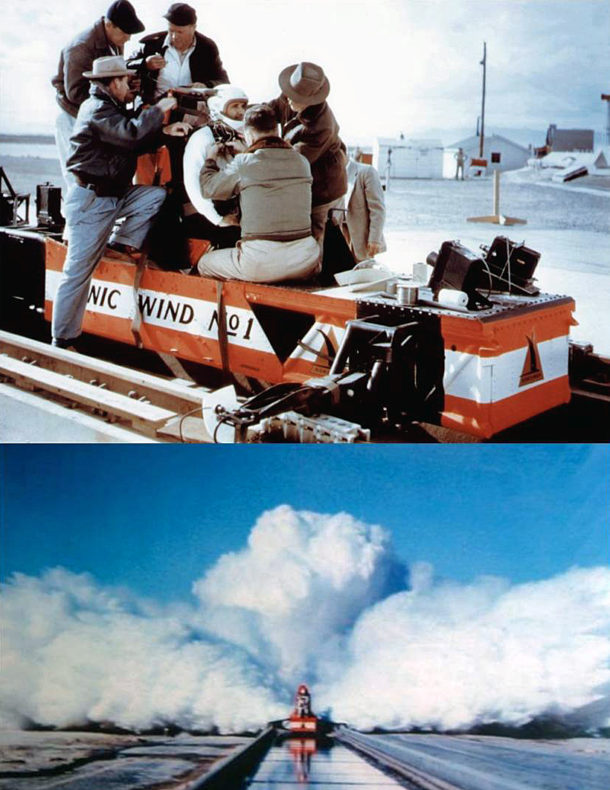
Sixty-two years ago this month, USAF Lieutenant Colonel John Paul Stapp set a record for human G-tolerance when his Sonic Wind #1 rocket-powered test sled decelerated from 632 mph to a full stop in roughly 1.4 seconds. In so doing, Stapp endured a deceleration load equal to 46.2 times the weight of his body.
The period immediately following World War II marked the beginning of a steady rise in the speed and altitude capabilities of military aircraft. These performance increases subjected aircrew to wider ranges of flight loads and physical stresses. Manifold aeromedical issues and crew safety concerns arose; particularly in the area of emergency escape from a stricken aircraft.
Abandoning an aircraft in flight under emergency conditions and surviving the experience has always been a sporty proposition. Ejection forces, wind blast, body limb flailing, parachute opening shock levels, and the like make it so. Add to this list the effects of atmospheric temperature, pressure and oxygen concentration, and one starts to get an appreciation for the severity of the situation.
John Paul Stapp was a USAF physician who had an abiding interest in the aeromedical aspects of emergency escape. He knew that too many pilots were dying in situations that could have been survivable if proper equipment and procedures were available. Stapp dedicated himself to improving the chances of aircrew survival.
Stapp was a pioneer in scientifically investigating the effects of acceleration and deceleration on the human body. In March of 1947, he began a series of deceleration tests using a 2,000-foot sled track at Edwards Air Force Base. A rocket-powered test sled named the Gee Whiz carried test subjects down the track and brought them to a sudden halt to produce specific deceleration levels.
Initially, Stapp’s test subjects were anthropomorphic dummies and primates. However, he had always held to the belief that the best test subject would be a human. Better yet, a human who possessed extensive medical knowledge. Stapp selected himself for the assignment.
Stapp took his first ride down the Edwards sled test track on Wednesday, 10 December 1947. By May of 1948, he had riden the Gee Whiz a total of 16 times. One run resulted in a deceleration of 35-G’s. This meant that Stapp briefly experienced a force equal to 35 times his normal body weight during deceleration. In so doing, he pointedly dispelled the prevailing notion that a human being could not survive a deceleration level beyond 18-G’s.
Riding the sled was a form of physical abuse. Among numerous injuries, Stapp received several concussions, broke the same wrist twice, cracked ribs, and sustained retinal hemorrhages for his time on the track. All in an effort to find ways to preserve the lives of aircrew. Stapp, other human volunteers and chimpanzees continued sled testing on the Edwards track until 1953.
Stapp transferred to the Aeromedical Field Lab at Holloman Air Force Base, New Mexico in early 1953. He now had a longer track (3,550 feet) and a faster sled (Sonic Wind #1) with which to expand his deceleration research. The system was checked-out using a new crash test dummy and then a live primate. Stapp made the first human run on the Holloman track.
John Paul Stapp completed his 29th and final experimental sled test run on Friday, 10 December 1954. Propelled by a set of 9 rocket motors producing 70,000 pounds of thrust, the Sonic Wind #1 hit a peak velocity of 632 mph (Mach 0.9 at the test site altitude). Stapp endured a maximum acceleration of 20 G’s and then an incredible peak deceleration of 46.2-G’s during 1.4 seconds of slow-down. At that moment, he weighed 6,800 pounds.
Stapp took a severe pounding during his record ride. There were the “usual” body bruises, lacerations and harness burns. However, the worse effects involved his eyes. Both hemorrhaged and were completely filled with blood. Stapp indicated that all he could see was a watery salmon-colored fluid. Happily, his vision would return to quasi-normal by the next day. Stapp sported a pair of world-class shiners as peculiar momentos of his extreme deceleration experience.
Characteristically, Stapp had plans to go faster and endure more G’s. Indeed, the proposed Sonic Wind #2 test sled would be capable of driving him in excess of 1,000 mph and decelerating at more than 80 G’s. Such was not to occur as USAF would not allow Stapp to risk all again as a sled test subject.
John Paul Stapp’s legendary work produced enormous dividends in helping develop equipment, techniques and procedures that have saved the lives of countless aircrew. But the benefits of his research have gone well beyond that. Today, automobile safety standards are based in large measure on Stapp’s pioneering deceleration work. His legacy continues in other ways as well. Indeed, the 54th Stapp Car Crash Conference was held in November of this year.
John Paul Stapp, USAF officer, physician, sled test subject, was a man of uncommon valor and a bonifide hero in the truest sense of that over-used word. He willingly risked his life numerous times so that others might live. A man can do no more than that for his friends. On Wednesday, 13 November 1999, this man among men passed away peacefully in his sleep at age 89.
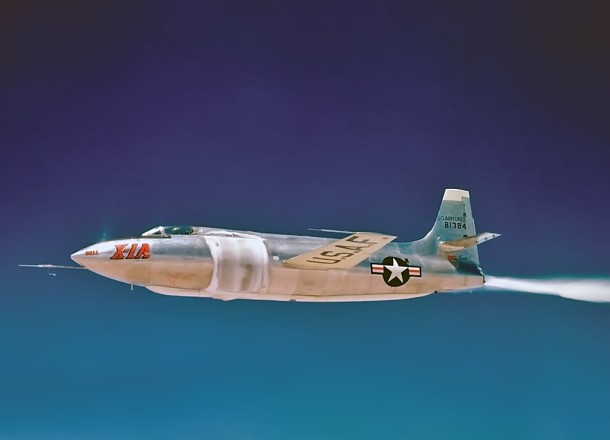
Sixty-three years ago today, USAF Major Charles E. Yeager set an unofficial world speed record of 1,650 mph (Mach 2.44) in the Bell X-1A flight research aircraft. In the process, the legendary test pilot very nearly lost his life when the aircraft departed controlled flight shortly after rocket motor burnout.
The USAF/Bell X-1A was a second generation X-aircraft intended to explore flight beyond Mach 2. It measured 35.5 feet in length and had a wing span of 28 feet. Gross take-off weight was 16,500 pounds.
Like its XS-1 forebear, the X-1A was powered by an XLR-11 rocket motor which produced a maximum sea level thrust of 6,000 lbs. The XLR-11 burned 9,200 pounds of propellants (alcohol and liquid oxygen) in roughly 270 seconds of operation.
Departing Edwards Air Force Base, California on Saturday, 12 December 1953, Yeager and the X-1A (S/N 48-1384) were carried to altitude by a USAF B-29 mothership (S/N 45-21800 ). X-1A drop occurred at 240 knots and 30,500 feet. Within ten seconds, Yeager lit off three of the XLR-11’s four rocket chambers and started to climb upstairs.
Yeager fired the 4th chamber of the XLR-11 passing through 43,000 feet and initiated a pushover at 62,000 feet. The maneuver was completed at 76,000 feet; higher than planned. In level flight now and traveling at Mach 1.9, the X-1A continued to accelerate in the thin air of the stratosphere.
Yeager quickly exceeded Scott Crossfield’s briefly-held Mach 2.005 record set on Friday, 20 November 1953. However, he now had to be very careful. Wind tunnel testing had revealed that the X-1A would be neutrally stable in the directional channel as it approached Mach 2.3.
As Yeager cut the throttle around Mach 2.44, the X-1A started an uncommanded roll to the left. Yeager quickly countered with aileron and rudder. The X-1A then rapidly rolled right. Full aileron and opposite rudder failed to control the roll. After 8 to 10 complete revolutions, the aircraft ceased rolling, but was now inverted.
In an instant, the X-1A started rolling left and then went divergent in all three axes. The aircraft tumbled and gyrated through the sky. Control inputs had no effect. Yeager was in serious trouble. He could not control his aircraft and punching-out was not an option. The X-1A had no ejection seat.
Chuck Yeager took a tremendous physical and emotional beating for more than 70 seconds as the X-1A wildly tumbled. Normal acceleration varied between plus-8 and negative 1.3 G’s. His helmet hit the canopy and cracked it. He struck the control column so hard that it was physically bent. His frantic air-to-ground communications were distinctly those of a man who was convinced that he was about to die.
As the X-1A tumbled, it decelerated and lost altitude. At 33,000 feet, a battered and groggy Yeager found himself in an inverted spin. The aircraft suddenly fell into a normal spin from which Yeager recovered at 25,000 feet over the Tehachapi Mountains situated northwest of Edwards. Somehow, Yeager managed to get himself and the X-1A back home intact.
The culprit in Yeager’s wide ride was the then little-known phenomenon identified as roll inertial coupling. That is, inertial moments produced by gyroscopic and centripetal accelerations overwhelmed aerodynamic control moments and thus caused the aircraft to depart controlled flight. Roll rate was the critical mechanism since it coupled pitch and yaw motion.
The X-1A held the distiction of being the fastest-flying of the early X-aircraft until the Bell X-2 reached 1,900 mph (Mach 2.87) in July of 1956. Yeager’s harrowing experience in December 1953 would be his last flight at the controls of a rocket-powered X-aircraft. For his record-setting X-1A mission, Chuck Yeager was awarded the 1953 Harmon Trophy.
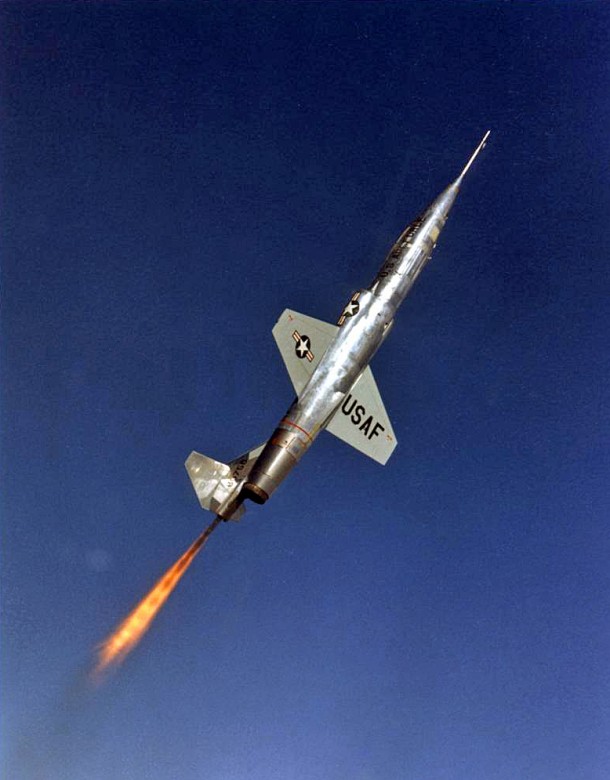
Fifty-three years ago today, USAF Major Robert W. Smith zoomed the rocket-powered Lockheed NF-104A to an unofficial world record altitude of 120,800 feet. This mark still stands as the highest altitude ever achieved by a United States aircraft from a runway take-off.
A zoom maneuver is one in which aircraft kinetic energy (speed) is traded for potential energy (altitude). In doing so, an aircraft can soar well beyond its maximum steady, level altitude (service ceiling). The zoom maneuver has both military and civilian flight operations value.
The USAF/Lockheed NF-104A was designed to provide spaceflight-like training experience for test pilots attending the Aerospace Research Pilot School (ARPS) at Edwards Air Force Base, California. The type was a modification of the basic F-104A Starfighter aircraft. Three copies of the NF-104A were produced (S/N’s 56-0756, 56-0760 and 56-0762). It was the ultimate zoom flight platform.
In addition to a stock General Electric J79-GE-3 turbojet, the NF-104A was powered by a Rocketdyne LR121-NA-1 rocket motor. The J79 generated 15,000 pounds of thrust in afterburner and burned JP-4. The LR-121 produced 6,000 pounds of thrust and burned a combination of JP-4 and 90% hydrogen peroxide. Rocket motor burn time was on the order of 90 seconds.
The NF-104A was kinematically capable of zooming to altitudes approaching 125,000 feet. As such, it was a combined aircraft and spacecraft. The pilot had to blend aerodynamic and reaction controls in the low dynamic pressure environment near the zoom apex. He was also required to fly in a full pressure suit for survival at altitudes beyond the Armstrong Line.
On Friday, 06 December 1963, Bob Smith took-off from Edwards and headed west for the Pacific Ocean. Out over the sea, he changed heading by 180 degrees in preparation for the zoom run-in. At a point roughly 100 miles out, Smith then accelerated the NF-104A (S/N 56-0760) along a line that would take him just north of the base. Arriving at Mach 2.4 and 37,000 feet, Smith then initiated a 3.75-g pull to a 70-degree aircraft pitch angle. Turbojet and rocket were at full throttle.
Things happened very quickly now. Smith brought the turbojet out of afterburner at 65,000 feet and then moved the throttle to the idle detent at 80,000 feet. The rocket motor burned-out around 90,000 feet. Smith controlled the aircraft (now spacecraft) over the top of the zoom using 3-axis reaction controls. The NF-104A’s arcing parabolic trajectory subjected him to 73 seconds of weightlessness. Peak altitude achieved was 120,800 feet above mean sea level.
On the back side of the zoom profile, Bob Smith restarted the windmilling J79 turbojet and set-up for landing at Edwards. He touched down on the main runway and rolled out uneventfully. Total mission time from brake-release to wheels-stop was approximately 25 minutes.
Much more could be said about the NF-104A and its unique mission. Suffice it to say here that two of the aircraft ultimately went on to serve in the ARPS from 1968 to 1971. The only remaining aircraft today is 56-0760 which sits on a pole in front of the USAF Test Pilot School (TPS) at Edwards.
Bob Smith went on to make many other noteworthy contributions to aviation and his nation. Having flown the F-86 Sabre in Korea, he volunteered to fly combat in Viet Nam in his 40th year. Stationed at Korat AFB in Thailand, he commanded the 34th Fighter Squadron of the 388th Tactical Fighter Wing. Smith flew 100 combat missions in the fabled F-105D Thunderchief; many of which involved the infamous Pack VI route in North Viet Nam.
Bob Smith was a true American hero. Like so many of the airmen of his day, Smith was a man whose dedication, service, and courage went largely unnoticed and unappreciated by his fellow countrymen. Bob Smith’s final flight came just 3 months shy of his 82nd birthday on Thursday, 19 August 2010.
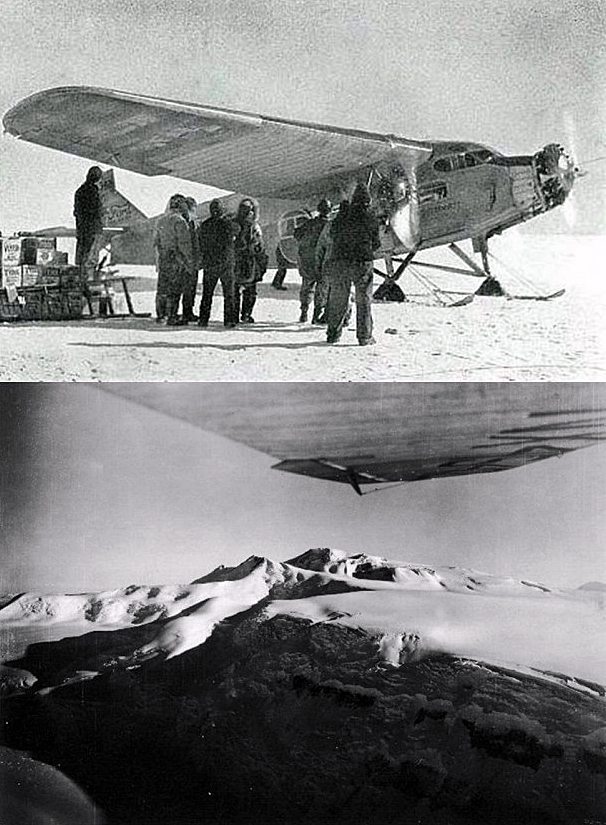
Eighty-seven years ago this week, a four-man crew became the first Antarctic explorers to fly over the Earth’s South Pole. The aircraft used to make the historic flight was a Ford Trimotor.
While substantial exploration of the Artic and Antarctic by land and sea had occurred far earlier, exploration of these regions by air was in its infancy during the decade of the 1920′s. Of particular focus was the goal to fly over both the North and South Poles.
The historic first flight to the South Pole originated from Little America, an exploration base camp situated on Antartica’s Ross Ice Shelf. Distance to the South Pole was about 800 miles as the crow flies.
A Ford Trimotor aircraft, the Floyd Bennett (S/N NX4542), was selected for the epic polar air journey. The crew consisted of pilot Bernt Balchen, co-pilot Harold June, navigator Richard E. Byrd, and radio operator Ashley McKinley.
The fabled Trimotor was well-suited for the rigors of polar flight. The all-metal aircraft measured 50-feet in length and had a wing span of 76-feet. Empty weight was roughly 6,500 pounds. Power was provided by a single 520-HP Wright Cylone and a pair of 200-HP Wright Whirlwind radial engines.
Following departure from Little America at 02:39 UTC, the Floyd Bennett headed for the South Pole. Navigation was via sun compass due to the proximity of the South Magnetic Pole.
Myriad glaciers, massifs, plateaus, and crevasses marked the stark, rugged landscape unfolding under the Floyd Bennett’s flight path. The most imposing of these geological features were the Queen Maud Mountains that towered more than 11,000 feet above sea level.
Pilot Balchen struggled to get his aircraft over the high mountain pass that runs between Mounts Fridtjof and Fisher. The crew jettisoned empty fuel cans and hundreds of pounds of precious food to lighten the load. The Floyd Bennett cleared the terrain by about 600 feet.
Just after 1200 UTC (local midnight) on Friday, 29 November 1929, the Floyd Bennett and her crew flew over the Earth’s South Pole. After briefly loitering around the Pole, the aircraft headed back to Little America at 1225 UTC.
According to plan, Balchen landed the airplane to take on 200 gallons of fuel that had been pre-positioned at the base of the Liv Glacier. The Floyd Bennett took-off again and landed back at Little America around 21:10 UTC. Total mission time was nearly 19 hours.
United States Navy Commander Richard E. Byrd now had flown over both poles. He would go on to successfully explore the Antarctic for many more years. For his part in the South Pole overflight, Byrd was promoted to the rank of Rear Admiral.
Today, the aircraft that made the first flight over the South Pole in November 1929 is displayed in the Heroes of the Sky exhibit at the Henry Ford Museum in Dearborn, Michigan.

Fifty-five years ago this week, a United States Navy YF4H-1 Phantom II set a world absolute speed record of 1,606.342 mph. Piloting the aircraft for this record flight was United States Marine Corps Lieutenant Colonel Robert B. Robinson.
The McDonnell Douglas YF4H-1 Phantom II was first flown in May 1958. The aircraft measured 58 feet length with a wing span of 38 feet. Gross take-off weight was 44,000 pounds. A pair of General Electric J79-GE-8 turbojets produced a total of 34,000 pounds of thrust in afterburner.
The YF4H-1 was the first in a long line of Phantom II variants that would eventually see a production run of 5,195 aircraft. Second only to the nearly 10,000 production units of the multi-variant North American F-86 Sabre.
Since 1961 marked the 50th anniversary of Naval Aviation, the US Navy planned to celebrate by establishing a series of speed records. The aircraft of choice was their super-powered Phantom II. Operation SAGEBURNER was the low altitude speed program (i.e., 125 feet off the deck) while Operation SKYBURNER was the high altitude speed component.
On Wednesday, 22 November 1961, the second YF4H-1 (S/N 142260) took-off from Edwards Air Force Base, California in an attempt to surpass the existing world absolute speed record. A United States Air Force F-106 Delta Dart, piloted by Major Joseph W. Rogers, held the existing record of 1,525.96 mph which was set on Tuesday, 15 December 1959.
Robinson had to fly a precisely-timed and positioned flight profile to extract maximum performance from his YF4H-1. FAI rules required the aircraft to enter the Edwards speed course in level flight and to make two runs. The final speed mark would be the average of the two runs.
The Phantom II was a big airplane and had to carry a lot of fuel. In addition to a full internal fuel load, the aircraft carried a 600-gallon centerline tank and a pair of 370-gallon wing tanks. Following take-off to the east, climb-out was made to the south toward El Centro, California. Arriving in the area, Robinson made a sweeping left-hand turn over the Salton Sea and accelerated the aircraft north back towards Edwards.
As the aircraft gained speed, Robinson dropped the empty centerline fuel tank over the Chocolate Mountains gunnery range. Then, arriving over the Bristol Dry Lake range, he punched-off the empty wing tanks. The aircraft was now lighter and aerodynamically cleaner.
Robinson approached the Edwards speed course from the east in full afterburner. The Phantom II exited the 20-mile course quickly. Following his first pass, Robinson came out of afterburner, made a Mach 0.9 turn to the south, cruised 105 miles out and then made the turn back to Edwards for the second speed pass.
His aircraft lighter now and not having to concern himself with the logistics of dropping empty fuel tanks, Robinson was clocked at over 1,700 mph on his second time through the Edwards speed course. The two-run average was 1,606.342 mph; a new world absolute speed record.
The F-4 Phantom II would go on to a legendary combat career in both the United States Navy and United States Air Force. Among many distinctions, the McDonnel Douglas F-4 Phantom II is the only aircraft to have seen service with both the USAF Thunderbirds (1969-1973) and the US Navy Blue Angels (1969-1974) flight demonstration squadrons.
For setting the world absolute speed record in 1961, Operation SKYBURNER pilot Bob Robinson was presented with the Distinguished Flying Cross by the then-Secretary of the Navy, John B. Connally.
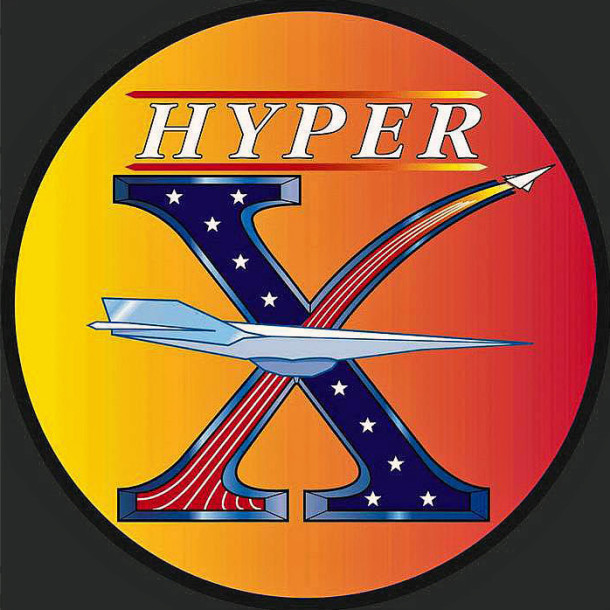
Twelve years ago today, the NASA X-43A scramjet-powered flight research vehicle reached a record speed of over 6,600 mph (Mach 9.68). In doing so, the X-43A eclipsed its own record speed of Mach 6.83 (4,600 mph) and became the fastest airbreathing aircraft of all time.
In 1996, NASA initiated a technology demonstration program known as HYPER-X. The central goal of the HYPER-X Program was to successfully demonstrate sustained supersonic combustion and thrust production of a flight-scale scramjet propulsion system at speeds up to Mach 10.
Also known as the HYPER-X Research Vehicle (HXRV), the X-43A aircraft was a scramjet test bed. The aircraft measured 12 feet in length, 5 feet in width, and weighed close to 3,000 pounds. The X-43A was boosted to scramjet take-over speeds with a modified Orbital Sciences Pegasus rocket booster.
The combined HXRV-Pegasus stack was referred to as the HYPER-X Launch Vehicle (HXLV). Measuring approximately 50 feet in length, the HXLV weighed slightly more than 41,000 pounds. The HXLV was air-launched from a B-52 mothership. Together, the entire assemblage constituted a 3-stage vehicle.
The third and final flight of the HYPER-X program took place on Tuesday, 16 November 2004. The flight originated from Edwards Air Force Base, California. Using Runway 04, NASA’s venerable B-52B (S/N 52-0008) started its take-off roll at approximately 21:08 UTC. The aircraft then headed for the Pacific Ocean launch point located just west of San Nicholas Island.
At 22:34:43 UTC, the HXLV fell away from the B-52B mothership. Following a 5 second free fall, rocket motor ignition occurred and the HXLV initiated a pull-up to start its climb and acceleration to the test window. It took the HXLV 75 seconds to reach a speed of slightly over Mach 10.
Following rocket motor burnout and a brief coast period, the HXRV (X-43A) successfully separated from the Pegasus booster at 109,440 feet and Mach 9.74. The HXRV scramjet was operative by Mach 9.68. Supersonic combustion and thrust production were successfully achieved. Total engine-on duration was approximately 11 seconds.
As the X-43A decelerated along its post-burn descent flight path, the aircraft performed a series of data gathering flight maneuvers. A vast quantity of high-quality aerodynamic and flight control system data were acquired for Mach numbers ranging from hypersonic to transonic. Finally, the X-43A impacted the Pacific Ocean at a point about 850 nautical miles due west of its launch location. Total flight time was approximately 15 minutes.
The HYPER-X Program was now history. Supersonic combustion and thrust production of an airframe-integrated scramjet had indeed been achieved for the first time in flight; a goal that dated back to before the X-15 Program. Along the way, the X-43A established a speed record for airbreathing aircraft and earned several Guinness World Records for its efforts.
As a footnote to the X-43A story, the HYPER-X Flight 3 mission would also be the last for NASA’s fabled B-52B mothership. The aircraft that launched many of the historic X-15, M2-F2, M2-F3, X- 24A, X-24B and HL-10 flight research missions, and all three HYPER-X flights, would take to the air no more. In tribute, B-52B (S/N 52-0008) now occupies a place of honor at a point near the North Gate of Edwards Air Force Base.











